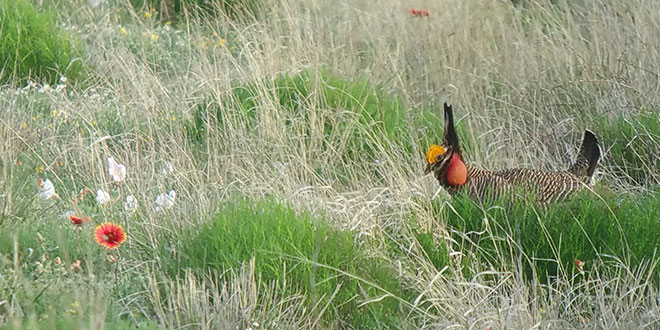Lesser prairie-chickens are a “lekking” species, where the males will congregate on a “lek” to attract females for breeding. Males will inflate the air sacs in their necks to make a sound that can be heard up to one mile away. The males will defend territories on the lek in order to have the best chance of mating with a hen. This will often involve fighting with their neighbors to defend their territory, which can lead to some pretty spectacular photographic opportunities.
The best time to photograph lesser prairie-chickens is during the peak of hen attendance; this usually takes place around the second week of April in New Mexico. The birds will arrive on the lek about 45 minutes prior to the sun rising, so you’ll need to be in your blind at least an hour before sunrise in order to beat the birds to the lek. I like to minimize disturbance to the birds by not flushing them from the lek unless it is absolutely necessary. The birds will display on the lek for around two hours. I always wait for the birds to leave on their own before emerging from the blind. I also never use a flash. The flash could spook the birds and cause them to flush from the lek. I always wait until there is enough natural light to take photos without a flash.

My photography gear is not elaborate. I have an old Nikon D5000 camera outfitted with a 70-300mm zoom. A fast shutter speed (> 1/1000 sec) is essential to stopping the action to get crisp, clear photos. A camera that can take anywhere from five to 10 frames per second is also ideal.
In addition, I have also used my phone camera with an adapter that attaches it to a spotting scope. This is known as digiscoping. The photo of the chicken with the blanket flowers the same color as its air sac was taken with a digiscoping setup from approximately 40 yards using my truck as a blind.

If using a tent blind, I will often set it up a few days in advance to allow the birds to get used to it. You can also use your vehicle as a blind, but you generally can’t get as close to the birds.
Lastly, always be mindful of private property rights and ask for permission to view birds on private land in advance. The Department’s prairie chicken areas are closed to the public during the breeding and nesting season, from Feb. 15 – June 30, to minimize disturbance to the birds during these critical times. Therefore, the only way a person would be able to photograph prairie chickens on a lek is either to find a lek on Bureau of Land Management property or by permission on private land.

Check out more of Grant Beauprez’s photos in the Fall 2019 edition of New Mexico Wildlife.
 New Mexico Wildlife magazine Conserving New Mexico's Wildlife for Future Generations
New Mexico Wildlife magazine Conserving New Mexico's Wildlife for Future Generations
